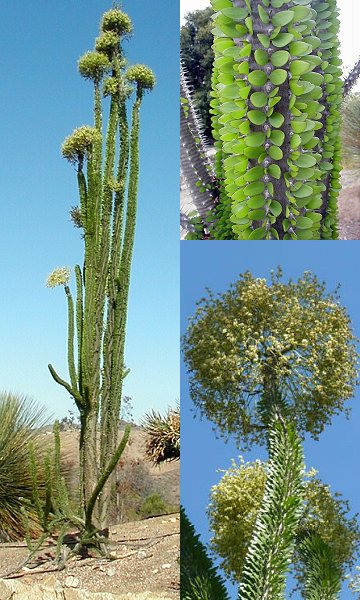
|
|
Madagascar ocotillo
(Alluaudia procera). Plant, leaves, flowers.
|
Madagascar ocotillo - Alluaudia procera
Madagascar ocotillo or Alluaudia procera, is a deciduous, dioecious
succulent plant species of the family Didiereaceae. It is endemic to south Madagascar.
Alluaudia procera is a spiny and scarcely branched or occasionally columnar, small succulent tree, up to 50 feet (15 m) tall with paired, up to 2 inches (5 cm) long, with thick water-storing stems and leaves that are deciduous in the long dry season.
Oval or rounded, succulent leaves (often leafless in high heat) and grey spines, up to 0.4 inch (1 cm) long that sprout up along the mostly unbranched upright, stout, whitish-gray stems. The stem is gray-green to bone white in color and up to 6 inches (15 cm) in diameter at the base. The flowers are yellowish or whitish-green in crowded clusters at the end of the branches.
Alluaudia procera, or Madagascar Ocotillo in many ways it resembles the American Ocotillo
(Fouquieria splendens), of the Sonoran Deserts in North America,
with red flowers. Both have small rounded leaves and grayish trunks with a lot of
spines, but that is where the similarities and in fact they belongs to two different
families. This is a perfect example of convergent evolution - unrelated plants adapting similar shapes and survival strategies in response to the same environmental
conditions.
It is one of the thorny plants of the Madagascan spine forests
(along with Pachypodium spp.). found in the islandís semi-arid southwest. It grows in areas that may receive no rain for more than a
year. It can withstand extended periods of drought, yet lacks the water storage tissues associated with most true
succulents.
Young alluaudias form a tangle of stems that last for several years after which a strong central stem develops. The basal stems then die out leaving a tree-like stem that branches higher up on the main trunk.
Like other members of Didiereaceae family, the leaves of Alluaudia, produced from brachyblasts similar to areoles found in cacti, are small, appear single and are accompanied with conical spines.
Spines are arranged around the leaves as a defense against herbivores. The spines are several meters above the ground, and probably evolved in response to herbivory by now-extinct lemurs, such as Hadropithecus. Several lemur species living today feed heavily on Alluaudia, such as the ring-tailed lemur (Lemur catta) and the white-footed sportive lemur (Lepilemur leucopus).
The plants is used for it's wood.
The heartwood is whitish yellow, however, often becomes greyish to greenish upon
exposure. The texture is moderately fine; it has a mottled structure because of the presence of large
rays. The wood is light in weight; not durable, and liable to attacks by fungi.
It is used in local house construction. The wood, known locally as 'fantsilotra', is also commonly used for boxes and
crates. It has been used for containers for tobacco and vanilla because it is
odourless. It is suitable for interior trim, furniture, laths for tile roofs, supporting
framework, veneer for inner layers of plywood, and particle board.
The wood is used for fuel and for charcoal production.
Source:
https://en.wikipedia.org/wiki/Alluaudia_procera
http://tropical.theferns.info/viewtropical.php?id=Alluaudia+procera
http://www.cactus-art.biz/schede/ALLUAUDIA/
Alluaudia_procera/Alluaudia_procera/Alluaudia_procera.htm
